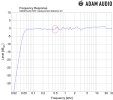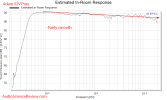There seem to be a lot of misconceptions coming up in this thread. I think a lot of people buy into shoddy marketing more than they should.
Are my monitors supposed to sound like crap so they catch every flaw? My monitors cost $250 CAD for a pair. I am wondering if I upgrade to Yamaha HS5 for $500 will it be much better sounding or sound even worse (read: catch even more flaws)?
No, they're not supposed to sound like crap. That being said....250CAD speakers are
not going to sound great. No, HS5s aren't a huge upgrade. I kind of think that, generally, the next step up is at around a grand for the set. But, that also doesn't mean that every $1,000 pair of speakers actually sounds good. And, I'll say it again, "studio monitor" is a marketing term, not anything to do with how the speakers actually sound. They're all just speakers with their own strengths and weaknesses and design compromises to hit a price point. There is no fundamental difference between what most people think of as studio monitors and what most people think of as hi-fi bookshelf speakers.
Audio Science Reviews has a lot of good information. And without knowing someone's preferences, this is actually a very good general ranking IME (sort decreasing by preference score):
https://www.audiosciencereview.com/forum/index.php?pages/Reviews/
Yeah, some designers like a sound that's brighter or warmer or scooped or forward or whatever. Some cones and box designs react more quickly than others, and yes, that can come across as harsh if the recording already tends that way. Some that react more slowly might smooth out some of that and cover up some of the harsh distortion that's in the recording.
But as far as some kind of change in a speaker that universally flatters everything....it just doesn't exist. I can't even imagine what about a speaker
would flatter
everything.
Harmon/JBL did a lot of research over the years, and that research is where the ASR "Preference Score" comes from. Generally, people tend to prefer speakers that are neutral (basically flat with a bit of a warm tilt compared to technically perfect) and quick-reacting but not supper-zippy (if that makes any sense).
As far as catching flaws...I don't even know where that idea came from. Maybe it was just NS-10s. But they were designed as hi-fi bookshelf speakers. They didn't have any bass, they were pretty efficient, and they had a sealed box that let most amps of the time control the cones in a really fast/zippy kind of way....so they tended toward exposing/exaggerating distortion and forced you to actually listen to the midrange as opposed to covering it up with impressive-sounding bass.
It could be that you just prefer the sound you're getting through headphones or your AC10 to what you're getting through those speakers. As for why....there are a LOT of potential reasons.
Have you tried to play recorded music through your monitors? At a loud volume? How does that sound?
That's a really important question.
Good studio monitors are designed to be flat and therefore quite uninspiring.
That's flat-out false.
Most "studio monitors" are not flat. The good ones, generally, are somewhere between flat and warm tilted. But that doesn't describe all of them by any stretch of the imagination. It's insanely expensive to actually make an accurate/flat speaker, and "flat" does
not necessarily mean uninspiring.
If you're listening quiet, a smile curve is probably going to sound better (and more inspiring).
If you're listening loud, that same smile curve is going to sound bad and a flatter sound is going to sound better (and more inspiring).
If you're listening
too loud, a frown curve is probably going to sound best, though I don't think "too loud" is ever inspiring, at least not for how I define "too loud".
The difference between top-end studio speakers and top-end hi-fi speakers, apart from some companies on either side that like a particular "house curve" is in the marketing. B&Ws tend bright (even the expensive ones). ATC studio speakers tend to have an upper-mid bump. They are (or can be) insanely expensive, very highly regarded, and fundamentally flawed in different ways. And, frankly, I don't like and would not spend much money on either brand....and yes, I've heard 6-figure systems from both.
I have some relatively cheap B&Ws attached to my TV. They sound good there in that context. Just for S&G, a few years ago, I tried them in my treated studio space....and I don't think I've ever heard such harsh, uninspiring,
terrible sounding speakers unless they were broken.
It doesn't really matter what it says on the box or the website. What matters is that the speakers you choose sound good when you play good recordings of music you like and
if you're "working", sound bad when you play flawed recordings.



